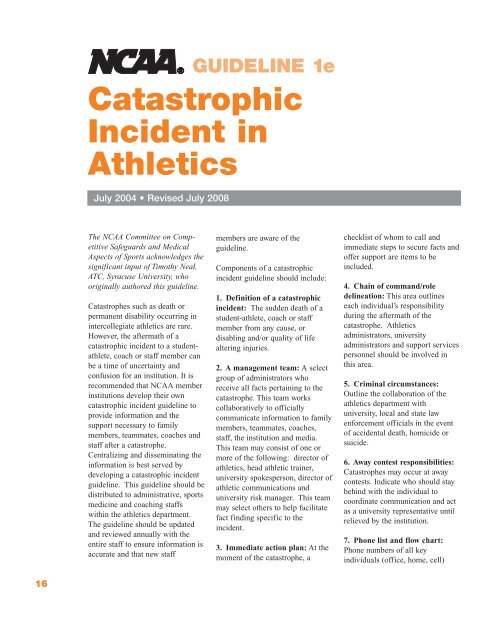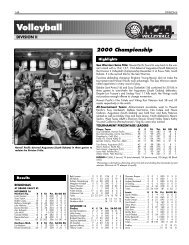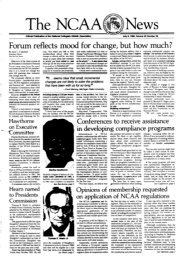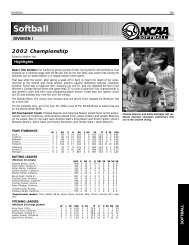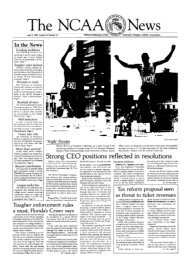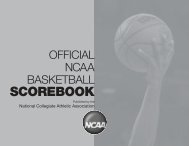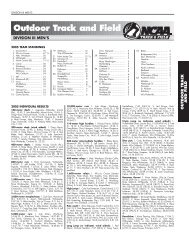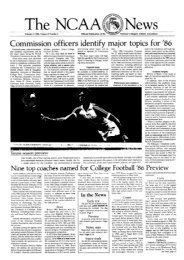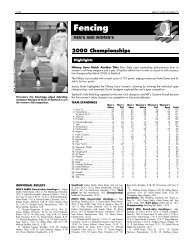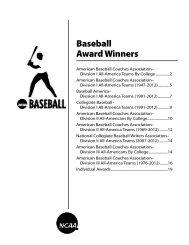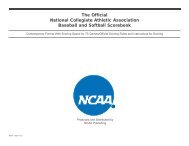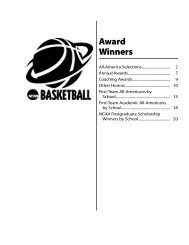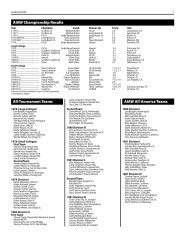Sports Medicine Handbook - NCAA
Sports Medicine Handbook - NCAA
Sports Medicine Handbook - NCAA
You also want an ePaper? Increase the reach of your titles
YUMPU automatically turns print PDFs into web optimized ePapers that Google loves.
16<br />
Catastrophic<br />
Incident in<br />
Athletics<br />
July 2004 • Revised July 2008<br />
The <strong>NCAA</strong> Committee on Competitive<br />
Safeguards and Medical<br />
Aspects of <strong>Sports</strong> acknowledges the<br />
significant input of Timothy Neal,<br />
ATC, Syracuse University, who<br />
originally authored this guideline.<br />
Catastrophes such as death or<br />
permanent disability occurring in<br />
intercollegiate athletics are rare.<br />
However, the aftermath of a<br />
catastrophic incident to a studentathlete,<br />
coach or staff member can<br />
be a time of uncertainty and<br />
confusion for an institution. It is<br />
recommended that <strong>NCAA</strong> member<br />
institutions develop their own<br />
catastrophic incident guideline to<br />
provide information and the<br />
support necessary to family<br />
members, teammates, coaches and<br />
staff after a catastrophe.<br />
Centralizing and disseminating the<br />
information is best served by<br />
developing a catastrophic incident<br />
guideline. This guideline should be<br />
distributed to administrative, sports<br />
medicine and coaching staffs<br />
within the athletics department.<br />
The guideline should be updated<br />
and reviewed annually with the<br />
entire staff to ensure information is<br />
accurate and that new staff<br />
GUIDELINE 1e<br />
members are aware of the<br />
guideline.<br />
Components of a catastrophic<br />
incident guideline should include:<br />
1. Definition of a catastrophic<br />
incident: The sudden death of a<br />
student-athlete, coach or staff<br />
member from any cause, or<br />
disabling and/or quality of life<br />
altering injuries.<br />
2. A management team: A select<br />
group of administrators who<br />
receive all facts pertaining to the<br />
catastrophe. This team works<br />
collaboratively to officially<br />
communicate information to family<br />
members, teammates, coaches,<br />
staff, the institution and media.<br />
This team may consist of one or<br />
more of the following: director of<br />
athletics, head athletic trainer,<br />
university spokesperson, dir ector of<br />
athletic communications and<br />
university risk manager. This team<br />
may select others to help facilitate<br />
fact finding specific to the<br />
incident.<br />
3. Immediate action plan: At the<br />
moment of the catastrophe, a<br />
checklist of whom to call and<br />
immediate steps to secure facts and<br />
offer support are items to be<br />
included.<br />
4. Chain of command/role<br />
delineation: This area outlines<br />
each individual’s responsibility<br />
during the aftermath of the<br />
catastrophe. Athletics<br />
administrators, university<br />
administrators and support services<br />
personnel should be involved in<br />
this area.<br />
5. Criminal circumstances:<br />
Outline the collaboration of the<br />
athletics department with<br />
university, local and state law<br />
enforcement officials in the event<br />
of accidental death, homicide or<br />
suicide.<br />
6. Away contest responsibilities:<br />
Catastrophes may occur at away<br />
contests. Indicate who should stay<br />
behind with the individual to<br />
coordinate communication and act<br />
as a university representative until<br />
relieved by the institution.<br />
7. Phone list and flow chart:<br />
Phone numbers of all key<br />
individuals (office, home, cell)


